| Article ID | Journal | Published Year | Pages | File Type |
|---|---|---|---|---|
| 10285024 | Construction and Building Materials | 2016 | 6 Pages |
Abstract
As well known, sulfate and phosphate are widely used additives for MOC products. In this work, the influence of FeSO4 and KH2PO4 on the properties of magnesium oxychloride cement (MOC) such as compressive strength, water resistance, thermal stability, composition and micro structure were studied in detail by using material testing system (MTS), X-Ray diffraction (XRD), thermogravimetry and differential scanning calorimetry (TG-DSC), scanning electron microscopy (SEM) and mercury intrusion porosimetry (MIP), respectively. The results show that both FeSO4 and KH2PO4 incorporation can benefit the formation of gel-like 5Mg(OH)2·MgCl2·8H2O (P5) and the water resistance of MOC. However, the FeSO4 and KH2PO4 incorporation can downgrade the thermal stability and the mechanical strength. The influence of KH2PO4 is more obvious than that of FeSO4. In addition, the hindering hydration of MgO caused by sulfate and phosphate ions result in reduction of the hydration product, while the double hydrolysis reaction between Fe2+ and MgCO3 leads to slight increase of the resultant in the slurry of MOC.
Keywords
Related Topics
Physical Sciences and Engineering
Engineering
Civil and Structural Engineering
Authors
Ying Li, Zongjin Li, Huafu Pei, Hongfa Yu,
